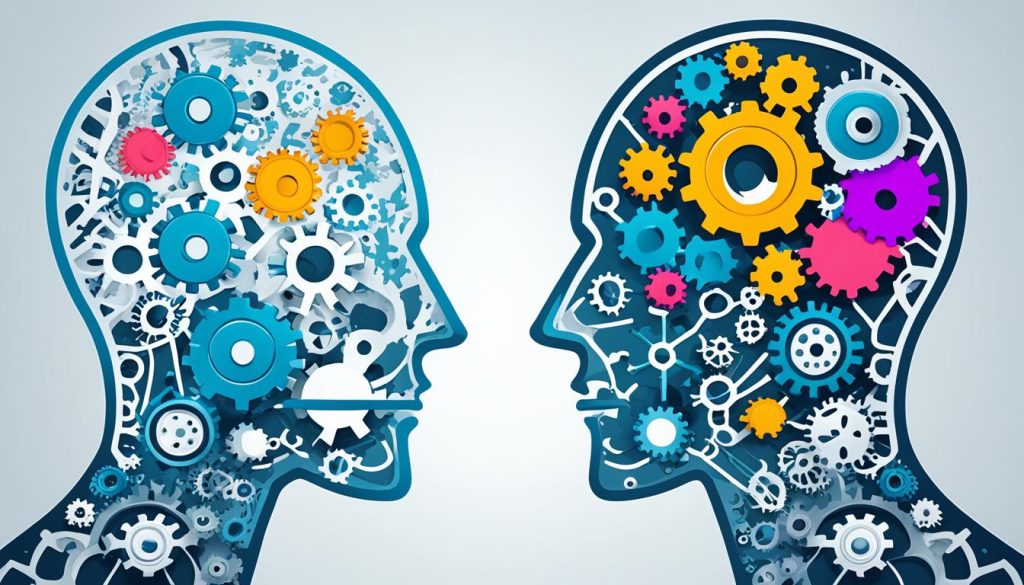Did you know new customers can get up to $300 in free credits to try out Vertex AI and other Google Cloud tools? This fact shows how big a deal Artificial Intelligence (AI) and Machine Learning (ML) are today. They’re changing the game in many areas and how companies work1. While people often mix up AI and ML, they’re really different technologies with their own strengths and uses. Knowing the differences helps us use these techs better. AI tries to do complex tasks fast, like humans do. ML looks at lots of data to find patterns and make predictions2.
In this article, we’ll show you how machine learning is different from AI. We’ll cover what each one does, their goals, and how they affect us. By making these ideas clear, you’ll be better equipped to make smart tech choices. You’ll understand the world of machine learning vs artificial intelligence better.
Key Takeaways
- AI means systems that think like humans, while ML is about analyzing lots of data.
- Machine Learning gets better with more data over time.
- AI can handle all kinds of data, but ML is best with structured and semi-structured data.
- Creating successful AI products needs careful planning, including using machine learning algorithms.
- AI and ML help make better decisions and work more efficiently.
- Machine Learning’s main goal is to train machines with data for better task performance.
- Challenges in AI and ML include data privacy, bias in algorithms, and needing tech skills.
Understanding Artificial Intelligence
Artificial Intelligence (AI) makes machines work like humans do, especially with computers. It includes many technologies that act like us, helping machines make decisions and solve problems on their own.
Definition of Artificial Intelligence
AI has different levels, like Narrow, General, and Super Intelligence. Each level shows how smart AI systems can be. They can handle all kinds of data, making them useful in many areas3.
Core Objectives of AI
The main aim of AI is to make machines do hard tasks that humans usually do. This includes understanding speech, talking like us, and making choices based on past experiences3. The idea of AI started in the 1950s, thanks to big steps in computing4.
AI Applications in Real Life
AI has changed many industries. You see it in smart devices, chatbots, and voice helpers like Siri. Companies use AI for better predictions and talking to customers, making things run smoother and improving customer happiness. For instance, stores use AI to manage stock and suggest products5. Hospitals use it for finding cancer early and studying genes, showing how AI can help in many ways5.

Exploring Machine Learning
Machine learning is a key part of artificial intelligence. It lets systems learn from data with little help from humans. This makes it different from AI, especially in predicting things and making recommendations. Knowing what machine learning does helps us see its role in the bigger picture of machine learning vs AI.
Definition of Machine Learning
Machine learning is about making algorithms that let computers get better over time from data. It uses many techniques to help systems spot patterns and make choices on their own. This makes machines better at understanding data6. This unique skill makes machine learning a special area focused on using data to make decisions.
Core Objectives of Machine Learning
The main goal of machine learning is to make systems that can learn and get better by themselves from the data they go through. This means they need to process data well to make better decisions over time. By automating how models are built, methods from statistics and neural networks help improve learning, showing how machine learning is different from AI7.
Applications of Machine Learning
Machine learning is used in many areas, fitting different needs. In finance, it helps spot fraud and make risk assessments. In healthcare, it helps with diagnoses and improves patient care with data insights. E-commerce uses it for better recommendations, making shopping more enjoyable. These examples show how important machine learning is in our data-driven world6.

| Application Area | Specific Use Cases |
|---|---|
| Finance | Fraud detection models, risk assessment tools |
| Healthcare | Diagnostic tools, personalized treatment recommendations |
| E-commerce | Personalized recommendations, customer insights analysis |
| Manufacturing | Predictive maintenance, quality control processes |
How does machine learning differ from AI?
To understand the difference between machine learning and AI, we need to look at their main differences in scope, focus, and methods. They work together but have different roles in technology.
Scope and Definition Differences
Artificial intelligence (AI) is a wide field that includes machine learning as a part. Machine learning helps systems learn from data, make decisions, and get better over time8. This shows how machine learning is a key part of AI.
Focus and Objectives Comparison
AI’s main goal is solving problems and making decisions like humans do. Machine learning focuses on recognizing patterns in data. For example, AI helps automate tasks and make decisions without people8. Machine learning aims to improve by learning from data and adapting its methods.
Methodological Differences
AI uses many methods, like neural networks and deep learning, to analyze data and make predictions on its own8. Machine learning mainly uses statistical models through supervised and unsupervised learning. These differences show why comparing AI and machine learning is important.
Connection Between AI and Machine Learning
Artificial Intelligence and Machine Learning work together closely. Machine Learning is a key part of AI. It uses data to learn and get better at certain tasks. This teamwork is seen in many real-life uses, making things work much better.
Machine Learning as a Subset of AI
Machine Learning is a special part of AI. It focuses on using data to make better decisions. It uses algorithms that learn from past data, getting better over time without needing to be told how to do things. This makes it very useful in many areas, like spotting fraud in banking or improving healthcare with images53.
Real-world Interdependence
In retail and finance, AI and Machine Learning work together to predict what customers will buy and manage stock better53. In customer service, AI chatbots talk to customers, and Machine Learning makes them smarter by understanding what users want and giving them personalized answers. This shows how important both technologies are for making systems that can handle complex tasks well9.
Differences Between AI and Machine Learning
It’s important to know how AI and machine learning work and their effects. AI uses many techniques like natural language processing and robotics. Machine learning focuses on learning from data with special algorithms. These differences show why people talk about machine learning versus artificial intelligence.
Comparison of Technologies
AI uses different technologies to solve various problems. For example, AI can understand and create human language with natural language processing. Machine learning, however, is all about recognizing patterns with algorithms.
Methods and Techniques Used
Machine learning uses supervised and unsupervised learning to work with data. AI often goes deeper with complex algorithms like genetic programming for different tasks. This shows a key difference between AI and machine learning.
Implementation and Infrastructure Needs
AI needs a strong setup to handle big data, which is key for deep learning. Machine learning also needs data and computers but can work with simpler setups. This shows how AI and machine learning differ in what they need to work.
Benefits of Integrating AI and Machine Learning
Combining AI and machine learning offers big advantages for your business. It makes your organization better in many ways. You’ll see better decision-making, work more efficiently, and automate tasks easier.
Enhanced Decision-Making
Using machine learning helps you make smarter, data-based choices. It lets you react quickly to changes in your business. This means fewer mistakes and better results1011.
Increased Efficiency in Operations
Companies that use AI and machine learning work more efficiently. This teamwork leads to saving money and using resources better10.
Automation of Processes
AI and machine learning automate boring tasks. This lets people focus on important, creative work. As these systems work better, your whole organization does too11.
Industries leveraging AI and Machine Learning
AI and machine learning are changing many industries. They make things work better, help make smarter decisions, and improve how we experience things. Each industry uses these technologies in its own way to solve unique problems.
AI in Healthcare
In healthcare, AI makes a big difference in patient care. It looks at health records to guess when patients might need to go back to the hospital. This makes things run smoother and helps patients get better faster.
AI and machine learning also help with making diagnoses, making things faster for patients, and getting treatments to more people12. These technologies have made huge strides, handling lots of data to give useful insights5.
Machine Learning in Banking
Machine learning changes banking for the better. It helps spot fraud by looking at transactions right away. It also makes customer service better with chatbots that talk to customers easily12. This mix of tech and finance makes banking safer and easier for everyone9.
AI in Manufacturing
Manufacturing uses AI to make things run smoother, like predicting when machines might break down. This means making things more efficiently and keeping costs down. With machine learning, factories can look at how well things are working and fix problems before they start5.
This new way of making things is all about being more efficient and flexible.
| Industry | Key Applications | Benefits |
|---|---|---|
| Healthcare | Patient record analysis, diagnostics, treatment accessibility | Enhanced patient outcomes, operational efficiency |
| Banking | Fraud detection, transaction security, customer service automation | Improved security, enhanced customer experiences |
| Manufacturing | Predictive maintenance, process automation | Increased productivity, reduced costs |
Looking at these areas shows how important it is to know the difference between AI and machine learning. They each bring unique benefits to how businesses work. Understanding this helps us see how AI and machine learning change the game in today’s business world9.
Challenges in AI and Machine Learning
AI and machine learning are growing fast, but they bring challenges. Companies face issues like data privacy, bias in algorithms, and needing special skills. These problems need careful attention.
Data Privacy Concerns
Handling lots of data with AI and machine learning raises big privacy worries. It’s key to have strong rules for data use to keep info safe. Finding the right balance between using data and keeping it private is hard.
Algorithmic Bias
AI and machine learning can carry biases from their training data. This can lead to unfair decisions in many areas. Companies must tackle these ethical issues head-on.
Technical Expertise Requirements
AI and machine learning need a lot of technical know-how. Many companies struggle because they lack the skills for making and analyzing models. The complexity of these technologies makes them hard to use widely. This underlines the importance of training workers in these areas.
Conclusion
Knowing the difference between machine learning and AI is key for using these powerful technologies well. AI tries to make machines think like humans in many tasks. Machine learning, on the other hand, learns from data to get better at specific tasks13. Since the 2010s, AI has grown a lot and is now used in many areas like healthcare and finance. It helps with things like spotting fraud, driving cars on their own, and making online shopping more personal14.
Machine learning is now vital for making better decisions by using data to predict outcomes15. As more companies use these technologies, it’s important they work together smoothly. This way, machine learning and AI can improve how things run and make results better. By understanding the differences, you can make smart choices for your company’s future in this fast-changing world.


